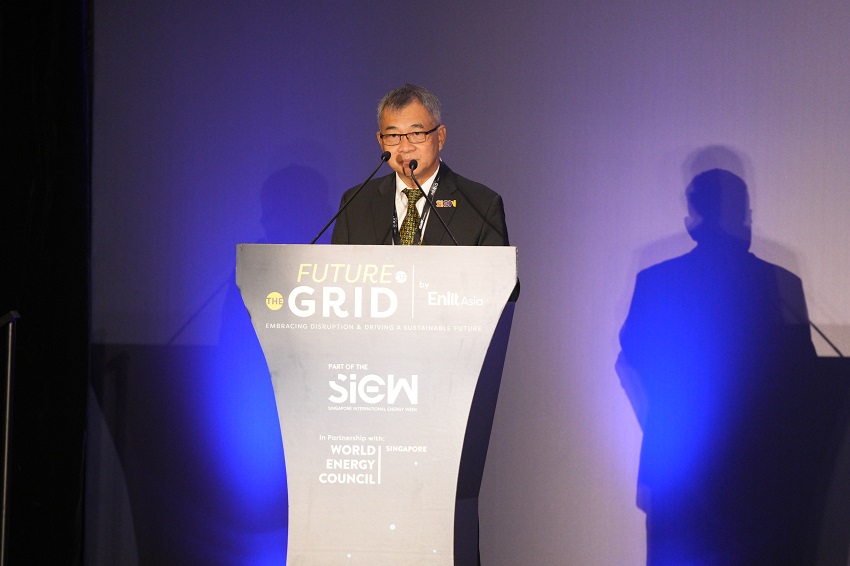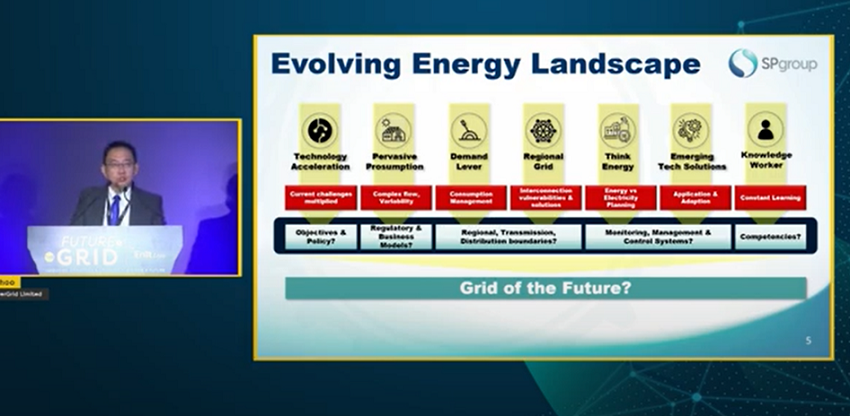
As electrification increases, power system transformation will be a key consideration in the energy transition. This would be crucial to meeting climate targets for both Singapore and the region. Making this point was Energy Market Authority (EMA) Chairman Richard Lim at the inaugural staging of the Future of the Grid.
The event, held on 28 October in conjunction with SIEW 2021, gathered senior experts to discuss the challenges, policies and strategies needed to transform our future grid.
In his Opening Remarks, Mr Lim also said that transitioning to an electrified economy efficiently, economically and securely would be essential. He addressed the need to balance the transformation with the three pillars of the energy trilemma—economic growth, environmental sustainability and energy security. At the same time, he reiterated that the energy transition must also be paced in a carefully calibrated way to ensure energy security and reliability.
Powering a more resilient, smarter grid for Singapore
The EMA Chairman mapped out the various policies and initiatives that Singapore has in place to position its power grid for greater resilience, amid changes brought on by electrification. Singapore will progressively roll out a smarter grid and improve the grid architecture, while developing advanced control systems and leveraging digital technologies such as a Grid Digital Twin.
Mr Lim also outlined solutions including Energy Storage Systems which will be crucial to stabilising the grid against intermittency challenges from adding more renewables to the mix. Singapore is also driving more research projects to test-bed low carbon technologies. In addition, an Energy 2050 Committee has been commissioned to examine the long-term trends affecting the energy sector, and to recommend strategies to navigate sustainably towards a net-zero future.
As different countries are endowed with different energy resources, Mr Lim shared that Singapore is looking to import low carbon energy from the region. The country will be conducting small-scale trials for electricity imports with regional partners, as part of supporting the development of a regional power grid.
Looking beyond to the future

The event also saw Jimmy Khoo, Chief Executive Officer, SP PowerGrid Limited, outline major trends that are expected to impact the grid. He said that while it is hard to predict what the future grid will look like, we can help to shape it. In his Keynote Address, he presented seven focus areas that he hopes will help frame questions to consider for the future grid.
The first trend, on technology change, is something that Mr Khoo said the power sector is constantly grappling with. One key question arising from the non-stop technological breakthroughs would be how to create flexible systems that can deal with the rapid technology acceleration.
Mr Khoo also noted that pervasive prosumption is happening worldwide and is seeing a blurring of lines between transmission system operators and how distribution systems operate. He added that as the centre of gravity changes in terms of balancing the grid, questions would revolve around the flow of demand and supply, and whether decentralised or centralised management would be more effective.
In balancing the grid, Mr Khoo also reflected on whether it would be better to manage demand rather than traditionally managing supply. He felt that this could be a hybrid model in the future, but also wondered if we could truly harness demand as a lever, and whether the future grid would be network or market-driven.
Singapore has announced that it is planning to import up to 4 gigawatt (GW) of low carbon energy from its regional neighbours by 2035. Mr Khoo remarked that this means the future will no longer be about isolated grids. Larger grids and networks could also translate to greater redundancy and hence greater resilience. While this is a good thing, it begs the question of whether the more connected the network is, the more robust?
The energy future will likely no longer be conceived of in terms of electricity grids, but as energy systems. Again, Mr Khoo said this would frame the questions differently around circular economies, energy reuse and waste recycling as an energy system. On top of that, there would be questions—such as how to bring the disparate energy systems together, and who would lead these efforts.
Speaking on the sixth trend, Mr Khoo shared that Gartner's Hype Cycle for Emerging Technologies puts power electronics at the forefront of the cycle. However, before we put our bets on the technology winners, we also need to ask if we should wait and see, or learn how to use these technologies first, he said.
While the final trend was presented last, it clearly carries equal weight in the future grid conversation. Mr Khoo acknowledged that too often in talking about hardware and software, we typically miss out the "heartware". He suggested that the future worker would be a digital native who is comfortable with technology. The questions here would be centred on what role technology such as artificial intelligence has to play, and how man and machine can work together.
The SP PowerGrid CEO concluded by reiterating his earlier comment—that there is no model answer to what the future grid will look like. That said, Mr Khoo believes asking questions around the seven focus areas will help shape essential thought processes on what needs to be answered. Perhaps, in doing so, we may find partial answers that can then help bring forth the grid of the future.
Follow us on Twitter (@SIEW_sg) to get the latest #SIEW2021 updates throughout the day!